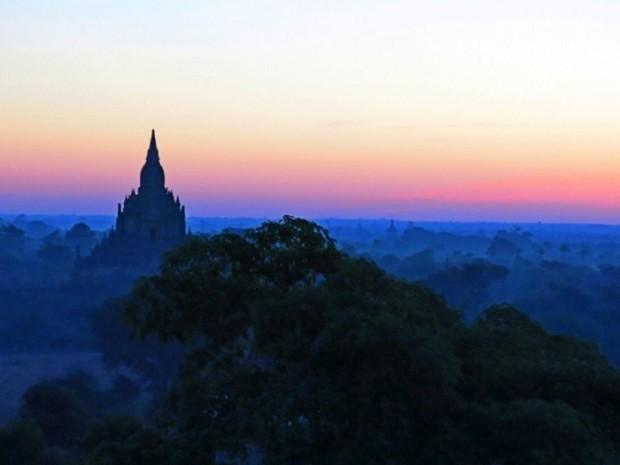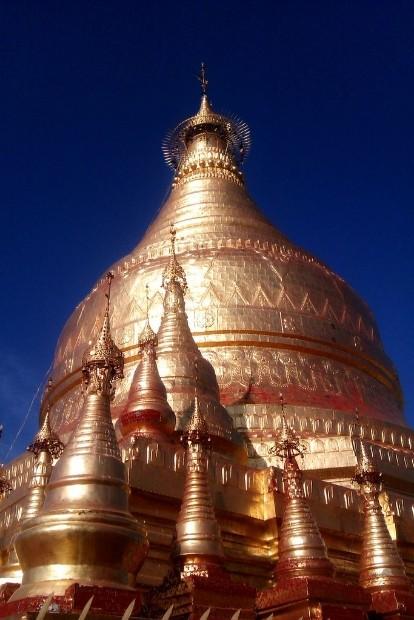I’m not much inclined to get up before dawn. The more so when it’s New Years Day and I’m engaged in trying to navigate unlit streets on an ancient bike with no gears. My body is telling me it wants to be asleep, and my brain is just about registering all the signs of a third world town just waking up – people huddled around cooking pots lit only by the glow of the wood fires set well before even I had risen.
I am so glad I didn’t give in to sanity because this day was set to become one of the most varied and memorable I have experienced in a very long time. But I am getting ahead of myself.

We had just one day in Bagan, having arrived by air from Yangon the previous evening. We were lucky in that a very hasty exit from the airport and a savvy taxi driver had us at the main sunset spot at the Shwesandaw Paya in time for the spectacle. We had anticipated a crowd of tourists but it wasn’t nearly as crowded as I had expected and as it transpired was by far the largest number of people in one place we ever saw in Bagan.
One of the advantages of a place with literally thousands of temples spread over many square miles is that you can get away from people if you want. And if there is one thing I’ve learned, it’s that I’m not alone in avoiding pre-dawn wakeup calls. So on our arrival at Dhammayazika Paya we weren’t too surprised to share sunrise with perhaps 20 others. There is something about sunrise which is more joyful than sunset, especially when everyone is in awe and speaking in whispers. To see the most notable pagodas emerge from the hazy gloom is just magical.

And then you look around and realise the pagoda you clambered up in semi-darkness is pretty photogenic in its own right.

Now we can put away our torches as the daylight has arrived, but the advantage of starting this trek before dawn becomes apparent as the heat begins to rise quickly. There is very little shade around, but lots of deep dust on the unmade tracks which proves to be very effective in producing unintended emergency stops. So we learn to stick to the side of the tracks and pull over for the occasional motorbike or bus like the one heading this story, which has been pressed back into service to act as ground crew for the wealthy tourists with the money to float over the pagodas in the early morning.

The map at the end of this story (click on it for a big version) proved utterly invaluable in navigating the maze of dirt tracks and locating the best pagodas, but really there are no ‘best’ sights – all are memorable, different, and many of the smaller ones have a charming intimacy, almost as if you are the first person to discover them. We took a northerly curve via Pyathatgyi and the Sulamani Pahto to Dhammayangyi and Ananda, a great white giant that can be seen from just about anywhere. Plenty of signs of earthquake activity in the past and plenty of buddhas – this duo is apparently quite unusual. – and contented.

And so, after crossing the city walls of Old Bagan, we arrived at a hotel right by the Irrawaddy River for a much needed late breakfast. The hotel was full of French tourists, so the quality of the food was way better than average! A gentle ride south on surfaced roads with a stop for some souvenirs brought us back to New Bagan and our hotel. If you have read any of our Tips articles, you may have seen one about the Green Elephant restaurant. Suffice to say this pan-Asian place is justifiably highly recommended, but not accurately located on any map we’ve seen and certainly not in the major guidebooks. Add to that the fact that there are two restaurants with the same name, each posting signs pointing often in opposite directions almost next to each other, and you can be forgiven for being confused. At least for lunch we located one of them! And then went for a walk by the river to locate the second. If you have a need to know precisely where they are our advice is here.
The afternoon had only just arrived and we felt as if we had had an extremely full day already, but I had a yearning to cross the river. Tan Kyi Paya i on the opposite bank of the Irrawaddy. For a ridiculously small amount you can hire your own boat and to cross this mightily large river.

So far as we could see we were the only tourists taking this route and certainly the only ones to reach the temple at the top of the hill on the other side – there is some form of communication that allows the boat captain to get a Jeep to take us up by unmade roads on the far bank. The experience was incredible for the feeling of being entirely away from any tourist influences as well as the astounding view back over the river to the thousands of temples dotting the horizon on the plain around Bagan. Which is not to say that Tan Kyi Paya was in any way an anticlimax either.


As a final bonus, I recall the return trip included tea and peanuts…
And as if this was not enough for one day, we finished off for dinner at the Green Elephant on the Irrawaddy River bank with this view to close out a superb day in Bagan…

Please see more images of Bagan here.
[codepeople-post-map]
Very useful large scale map of Bagan tracks. Click on image to open full size.
[otw_is sidebar=otw-sidebar-2]




